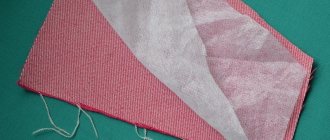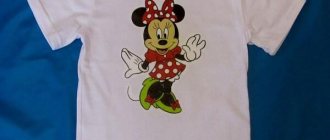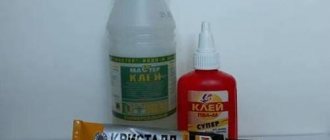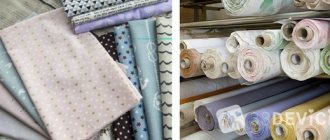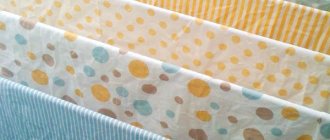Very often there are situations when clothes, bed linen or any other fabric items are torn. No one is immune from this. People face this problem almost every day, and there are several options for solving it. It is not always necessary to sew clothes or other items by hand or use a machine. The thought often arises: “How to glue fabric to fabric?” The answer to this question is quite simple, and everything you need for the process can be found on store shelves. You can use special adhesives for this purpose, for example, those suitable for appliqués, etc. There are many varieties, and the desired composition is selected according to the material itself.
What is it used for?
It is used for gentle gluing of cotton, textiles, jute, coconut fiber, felt and other fabrics. The glue is transparent, and due to this it can be used in the repair of clothing, awnings and screens. Thanks to it, you can easily remove small holes, tears, punctures and other minor damage. Fabric glue has become almost indispensable when working with decorations and edging carpets. It is also suitable for fixing appliqués or other fabric parts for quilting, machine embroidery and patchwork.
What is fabric glue?
There are several varieties: contact on a neoprene, butadiene-styrene or polyurethane basis, as well as hot-melt adhesive, polyvinyl acetate, nitrocellulose, perchlorovinyl, rubber and a number of others. There is also one specially designed for decoupage on fabric or for working with corduroy, cotton, wool and linen.
Fabric adhesives must adhere well to fabric products, so they are highly elastic and resistant to light, weather conditions and moisture. In this case, the properties are not lost due to temperature changes.
How to remove glue from skin
After working with glue, situations often arise when it gets on human skin.
To wipe it off, you can use several methods:
- Rub the remaining glue with your fingers and roll it into a small ball.
- Mix hot water with laundry soap. The stained areas are thoroughly wiped with soapy liquid until the adhesive structure comes off.
- Use sunflower oil. Wet your hands with vinegar and soap them. Wait 10 minutes. Using a swab moistened with oil, thoroughly wipe the dirty areas of the skin.
- Apply white spirit. This solvent can quickly remove adhesive residue from a dirty surface. However, its pungent odor and active components can negatively affect a person’s general condition.
If the above methods do not help, you can use a special chemistry called “Anti-glue Moment”. They need to treat dirty areas, wait the time indicated on the package, and wipe off any adhesive residue. Knowing how to remove glue from leather, you can safely carry out repair work.
Properties
A good glue should have a number of properties:
- Possibility of repeated re-gluing. At the same time, the stickiness should be maintained.
- High temperature resistance.
- When the glue dries quickly, the material should not be deformed.
- The glue must have good resistance to any detergents.
- It must have a transparent color, which allows it to be used for material of any color.
Composition selection criteria
The correct mixture will not only firmly connect the textiles, but will also avoid marks on the finished product. And it will be much easier to work with it than with the first material you come across.
For example, a universal textile composition is “Liquid Thread”. It copes well with all types of fabric. Including coconut and felt.
And for synthetic materials it is better to use “Oak”. Although this material is universal, it is non-natural fabrics that lend themselves better to it. For quick restoration, you can use an instant textile composition.
For example, “One second.” This glue works well on fabrics, leather, shoes, foam rubber and even porcelain.
But we must not forget that instant compositions dry out very quickly, and therefore they need to be used promptly.
Of course, you can use the usual composition to work with fabric. For example, PVA or “Moment”. They will also firmly “grab” the materials together.
But we still recommend using professional mixtures, since they are superior to competitors in quality:
- firstly, such compositions are colorless, which means the risk of spoiling the product is minimized;
- professional mixtures do not have a specific smell like the same “Moment”;
- the mixtures do not spread during operation, so they are much easier to use;
- When washing, you don’t have to think that the decor will suddenly disappear, since professional compositions are resistant to high temperatures and aggressive environments.
textile
material, we recommend starting from the following criteria:
- Water and heat resistance. Fabrics should easily withstand washing and ironing.
- When the fabric is stretched, even dried glue should form a thin film in order to firmly fix the elements even with active wear of clothing and accessories.
- The duration of drying of the composition should be such that the craftsman has time to correctly place all the elements. Otherwise, the product will be irretrievably damaged.
- The glue should “grab” any type of material equally well. Be it natural fabrics, synthetics or plastic fittings.
Attention! We recommend not choosing long-drying compounds for work, since working with fabrics and accessories requires quick drying.
Firstly, it is much more convenient when working. And secondly, the likelihood that the parts will corrode during drying is almost zero.
Aerosol glue
Thanks to the special formula on which it was created, it does not leak, does not deform the fabric and adheres to almost all types of matter. Very convenient for fixing patterns, sewing zippers and basting into a product. Before using spray fabric adhesive, shake it thoroughly. Then spray a small amount at a distance of 30 cm from the material that is being glued.
Advantages of spray adhesive:
- does not require auxiliary tools in the form of brushes or tampons;
- convenient when applied to the surface of fabric;
- able to penetrate hard-to-reach places;
- even on complex surfaces it is applied smoothly;
- Spray width is adjustable, which is economical;
- it has high heat resistance;
- does not dry out for a long time during storage;
- during gluing, long fixation is not required;
- allows you to adjust the material until the glue completely sets.
Repairing a down jacket
If the jacket is torn at the seam, there is no need to invent anything.
Such a hole can be sewn up with thread. First, it is recommended to visit a haberdashery store that sells suitable threads. It should be noted that such a gap can be eliminated even without a sewing machine. To make sewing more convenient, the jacket must be placed on the table, first turned inside out. It is important to sew so that the new line is a continuation of the old one. In this case, the seam should be as smooth as possible.
It is most difficult to sew up seams if the jacket has a lining. To make your task easier, you should make a small cut on the inside, which will also need to be stitched up.
If you carefully repair the damaged area, not a trace will be visible.
If a torn hole appears, you can not only sew everything up or apply a patch. Various types of applications are popular now. You can use this. Thus, you can not only get rid of the hole, but also update your down jacket.
Before mending a tear, you should visit the appropriate store to select a decal or pattern. A similar method can be used if the sleeve or main part of the jacket is torn.
Appliques and stickers can help out in many cases, but this method has a drawback. You can sew on a pattern or stick on a beautiful picture only where it is appropriate, namely:
- On the sleeves;
- On the chest;
- On the pockets.
In other cases, the stickers will look stupid, which means it’s best to consider another way to fix the holes. If embroidery was chosen, it should be done on a separate fabric, which will subsequently be sewn to the torn area of the jacket.
Braid or tape
You can disguise the hole next to the seam using tape. Many people are interested in the question of how to fix a hole in a jacket so that it is invisible and also beautiful. It's simple, you should use all your imagination. It doesn’t matter what length or color the braid is. Don't be afraid to experiment.
Another way to disguise a hole is with reflective tape. The advantage of this method is that it will not only hide the defect, but will also make the jacket visible at night. You need to cut a piece of tape and carefully stick it over the gap.
There are several ways to sew up or make a hole in your jacket invisible. Most methods are universal for all types of jackets. However, a certain method is better suited for each type. There are three ways to fix a hole:
- pull it off;
- seal;
- glue.
Repairing a down jacket varies depending on its type. Down jackets for men, women and children are repaired differently. Children's jackets are quite easy to repair, because a bright patch will look very organic on a children's down jacket. There is a huge variety of patches on the market.
Quite often the patch looks lonely on a jacket. In this case, you can stick a few more patches on undamaged areas. Thanks to this, the stripes on the down jacket will look organic.
A variety of patches are great for repairing women’s jackets, but men’s models are not so tolerant of such unplanned “modernization.” A bright colorful patch will look ridiculous on a strict men's down jacket. In order not to make a mistake when choosing a patch for a men's jacket, you need to give preference to items made in a strict, restrained style. Patches made of leather are well suited for men's jackets.
Despite the fact that winter jackets are in most cases made of reinforced materials, they can suffer from various types of damage, from snags to burns. Down jacket repair is carried out using several main methods:
- patches;
- thermal stickers;
- reflective tape;
- decorating the break point using a zipper or fittings.
The main difficulty when sealing a hole in a down jacket is the inconvenience. If the item is not repaired correctly, the filler may begin to come out. If the task seems difficult, it is recommended to take the jacket to the studio. Patch Thermal adhesive Reflective tape Zipper
Waterproof glue
It is used to repair all types of fabric: linen, wool, cotton, corduroy. For any combination of materials. Waterproof fabric glue is great for patches, zippers, hemming materials, making appliques, making jewelry and rag dolls, etc. This glue is easy to use. Initially it may be white so that it is visible on the fabric. But as it dries, it becomes transparent. The connection is very strong, does not wear out for a long time, and is resistant to washing (even in a machine) and ironing. Some types of glue are not suitable for synthetic fabrics. Many are resistant to cleaning products. To avoid stains, any glue should be tested on a small piece of the fabric used.
what kind of fabric? Description, properties, application
About half of the textiles produced are polyester. What kind of fabric is this, what is it made from? There is an opinion that synthetic fabrics are harmful, uncomfortable and unsightly. This is not entirely true: high-quality polyester is not only pleasant to look and feel, but also safe and practical. Let's find out what synthetic material is suitable for and how to care for it.
Composition and manufacture
What is polyester? This is a material made from polyesters - petroleum products. Production includes several stages:
- isolation of components for the production of polystyrene;
- obtaining liquid polystyrene from them;
- cleaning: mechanical and chemical;
- fiber production;
- finishing threads, giving them the desired properties;
- fabric production.
Despite the fact that polyester is made from petroleum products, its characteristics are similar to natural material - cotton. And the appearance of pure polyester is more like wool. Characteristics of the fabric: a good sample does not have an unpleasant odor, does not leave marks on the skin after wear, and does not fade. Clothes made from polyester fabric are comfortable to play sports in and allow the body to breathe. Synthetic textiles are also suitable for creating leisure clothing.
In addition to the versatility of polyester textiles, it is worth noting its sustainability. It retains its shape perfectly at temperatures not exceeding 40 degrees. Therefore, the manufacturer indicates on the label that the product is washed at this temperature. Fortunately, the material washes well in cold water.
Advantages and disadvantages
Positive properties include:
- Strength, wear resistance. Does polyester stretch or not? This material in its pure form is resistant to stretching and other physical impacts; for elasticity, additional fibers are included in the composition.
- Easy to wash. The fabric dries quickly and hardly wrinkles after washing.
- Polyester retains heat and does not get wet, so it is often used for sewing outerwear. Synthetics protect against adverse weather conditions: wind, rain and snow. These clothes are comfortable to wear in cold weather.
- Polyester is easy to cut and sew textiles. The fabric drapes well.
- This is a light material, pleasant to the body, with a cooling effect.
- High-quality polyester-based materials look beautiful.
- With proper care, it retains its rich color and does not deform.
- The advantage of synthetics is that they are not of interest to insects. There is no need to be afraid of moths and other pests.
- The fabric is resistant to the absorption of odors and the appearance of persistent greasy stains.
- Low cost allows synthetics to compete with natural fabrics in the textile market.
But the material also has a lot of disadvantages:
- He becomes electrified. Due to the accumulation of static electricity, dust sticks to the products, and the fabric itself sticks to the skin. To eliminate this drawback, you have to use an antistatic agent or buy a special conditioner for washing. Some manufacturers add antistatic fibers to the fabric to solve the problem.
- Pure polyester is quite hard and can chafe. To soften the material, natural cotton fibers or elastane are added to it.
- Polyester clothing is not suitable for hot weather due to its density.
- To remove stubborn stains from this type of synthetic fabric, you will have to try, since chemical bleaches damage the fibers.
- Polyester fabric can cause allergies, so such clothes are harmful to health, especially cheap ones.
- The fabric is flammable.
A variety of textures is possible thanks to different ways of weaving threads and adding other fibers. This is how knitwear, lace, and warm linings appear.
Some properties of synthetic matter cannot be clearly described as positive or negative. Thus, low elasticity allows clothes to keep their shape, but partly hinders movement. A controversial property is the ability to change shape when heated. This feature is useful when creating folds: simply iron the fabric with a hot iron and fix the desired fold. But if you use the iron carelessly, this property will play a cruel joke on you: one awkward movement, and a bend will appear that is difficult to get rid of.
Types of matter and their applications
Pure polyester is a smooth fabric that resembles silk. Products made from 100 percent polyester are rare. The most popular additive is cotton; combinations with wool and viscose are also used. So, polyester + viscose is a durable and elastic material. No less often, polyester itself acts as an additive. A mixture of polyester and elastane - a polyurethane synthetic fiber - a material with a high elasticity index. The fabric containing these components is resistant to deformation and wear, breathable, and looks beautiful.
Popular polyester-based fabrics:
- Oil is a knitted fabric, thick and warm.
- Micro-oil is a combination of polyester (70%) and viscose (30%). This knitwear looks like silk.
- Stretch polyester fabric - 5-15% elastane and 85-95% polyester. Used for sewing sports suits, underwear, swimsuits.
Lining and upholstery materials are most often made from polyester fiber. They do not allow moisture and heat to pass through, do not wrinkle, and retain their original properties for a long time. The lining for outerwear has increased heat-protective properties. Polyester lining can also be found in suits, jackets, trousers, bags, and backpacks. Another industry where polyester has been used is home textiles. Synthetics are added to curtain fabrics, rugs, rugs, blankets, bed linen, and tablecloths.
Holofiber - filling for outerwear - is obtained from polyester fibers. It retains heat well. These materials are also made from polyester:
- isosoft,
- polyfiber,
- fiberskin,
- thermofab.
Rules of care
How to extend the life of your favorite synthetic products and not spoil new ones:
- Clothes made of polyester are washed at a temperature not exceeding 40 degrees.
- Washing machines have a mode for synthetics, and an equally gentle - delicate mode. It is better to wash particularly delicate fabrics by hand without washing them.
- Do not use bleach. It is better to take the product to dry cleaning.
- The stain can be removed with a soap solution or a gentle stain remover.
- Polyester knitwear does not need to be twisted when wrung out.
- After washing, the item is dried after straightening it. That way she won't get wrinkled.
- Iron items from the wrong side at minimum temperature. It is better to protect the fabric with gauze. If you stroke the front side, an unsightly shine may appear.
Advice: Always check the instructions on the label if the item has special properties (for example, water resistance). Some fibers cannot be ironed. The manufacturer's recommendations will allow you to avoid unpleasant situations.
Polyester is a universal material that is used everywhere because of its positive characteristics. Despite many advantages, polyester material still remains synthetic. And only you can decide whether to buy textiles made from natural fabrics, or give preference to the more affordable polyester.
gidpotkanyam.ru
How to choose glue
The choice depends on the composition, surface and other parameters of the fabric to which the material is glued. Before purchasing glue for gluing fabrics, you need to look at its purpose, features, and how it works with different seams and knots.
For items that are washed, it is necessary to use glue that provides a durable, elastic seam that does not break down in water. In order to connect elements of outerwear, those types that are resistant to temperature changes and dry cleaning are suitable.
When choosing an adhesive, you need to understand that a person will be in direct contact with the product. Therefore, it should be safe for the skin and not cause irritation or allergies. In this case, the most suitable compositions are those that do not contain harmful substances and are resistant to fabric aging.
What to do if the glue left a mark
Getting glue onto areas of fabric and plastic elements is a common occurrence that almost all needlewomen encounter. There is nothing dangerous in this situation or that could ruin the finished product. Even the simplest available materials are suitable for cleaning fabric.
We share some effective tips:
- To remove excess material, you can moisten a cotton pad with gasoline and then wipe the contaminated area with it.
- Regular talc also works well with glue - you need to sprinkle it on the glue stain, and then remove it with a regular cloth.
- Table soda works on the same principle.
- Vinegar is also suitable for getting rid of excess glue. They also need to wet a cotton pad or paper towel and then run it over the contaminated surface until completely clean.
Kak klej ubrat' s odezhdy
When using professional mixtures, be sure to follow safety precautions. Protect skin from contact with glue. If this is impossible to do for some reason, purchase environmentally friendly mixtures. This way you will avoid allergic reactions, irritation and chemical burns.
Application
There are many types of fabric glue, and they all differ in properties and technology of use. For example, all substrates are coated with rubber and left until completely dry. After an hour, the resulting film is moistened with acetone, a cloth is applied to it, and a weight is placed at the joint for five minutes. It takes 10 hours for the glue to fully set.
How to glue fabric to fabric with perchlorovinyl compound? The surfaces of the material must be coated with a double layer. In this case, the first one dries for 10 minutes, and the second one - 3. Then the seam must be rolled with a roller and left for two days under load. Oak glue is applied to a cloth previously moistened with acetone. This is done using a two-layer coating method with a break of 3 minutes. After this, a load is placed on the seam for a couple of hours.
How to glue fabric to fabric when using nitrocellulose glue? The bases must be connected immediately as soon as they are missed, and a load must be placed on top. The polyvinyl acetate composition is applied to both surfaces, which are applied to each other after 3 minutes. Then a weight is placed at the joint and left to dry for six hours. It takes 12 hours for the glue to set.
How to glue fabric to fabric with silicone types of mixture? A special gun is used that heats the composition. It is applied to the material and it hardens without damaging the fabric. Such gun adhesives are available as sticks of different diameters. The dry silicone composition is simply poured between the fabric and ironed with a regular iron.
How to decorate the damaged area?
The most common problem is seam tearing. Such damage can be caused by a snag in the fabric, a sharp jerk, or poor quality sewing. Dealing with the problem is quite simple. To do this, you will need to take threads of a suitable color and a needle. You also need to know how to properly repair a hole on a down jacket using a machine.
If the garment has a lining, before sewing up a hole in the jacket, you should rip the seam open to make it easier to get to the tear. You need to work as carefully as possible; the stitching should be barely distinguishable from the factory one. To enhance the strength of the new seam, it must be made longer than the size of the hole.
If you don’t want to rip out the inner layer of clothing, you can repair the down jacket with a hidden or invisible seam. To do the job correctly, you should insert the needle into the inside of the jacket so that the knot of thread is invisible. After this, you need to make a parallel seam with stitches from the outer part of the garment.
In sewing stores you can easily find emblems, stickers, ribbons and other decorative elements of a wide variety of themes. But they have a significant drawback: they are not always appropriate. Such elements will look more harmonious on the chest and sleeves.
- Decorative patch. Find a suitable patch and baste it to the jacket so that it covers the hole. Then all you have to do is topstitch it or sew it with a blind seam.
- Leather or denim patches in the shape of geometric shapes will look harmonious and interesting on the jacket.
- Thermal adhesive for fabric. To apply it, attach the sticker to the jacket, cover with cloth and iron. If such a sticker looks too lonely, you can stick another element of the same theme on the other side.
- A cut or small hole in a child's or sports jacket can be sewn up using reflective tape. It is better to sew it not on one section, but around the sleeve or the entire jacket.
- A straight hole can be decorated using a short zipper sewn along the cut line.
These methods will help not only solve the problem of a torn jacket, but also make the item more interesting and even exclusive.
How fabric is glued
If it is necessary to connect two pieces of fabric without stitching, special adhesives are used. Thanks to them, the necessary strength is provided, which is not inferior to factory seams. How to glue fabric to fabric? In order for the connection to be unnoticeable, you need to cut off the edge fringe. Then the pieces of material are tightly fitted to each other. The overlay is cut out. This is a strip of one of the fabrics used, 2 cm wide. To prevent the glue from appearing on the front side, the joint and the overlay must be moistened with water and wrung out well.
After this, a thin layer of the composition is applied with a brush to the overlay, which is glued. Then the same is done with the reverse side of the fabric, at the site of the intended connection. The glue is kept for some time until it stops sticking. Then apply a second layer and allow to dry.
An overlay is applied to the pressed edges of the fabric from the inside out, covered with another material and pressed with a hot iron for 10 seconds. Then it is removed, and after 4 seconds the procedure is carried out again. In this way, the process is repeated until the fabric is completely dry. After this, it should cool completely. When using an iron, you need to take into account its temperature, which must correspond to the fabric being glued.
Quick repairs in the forest
Are you interested in how to quickly seal up a camping tent while camping? Most experienced tourists will advise using reinforced tape. Even a small piece of this material will be enough to repair damage right on the hike and continue enjoying your vacation.
If you don’t have tape with you, you can use glue and a small piece of any fabric. All you need to do is cut a suitable piece of material and then glue it to the damaged area. After this, all that remains is to carry out better repairs at home.
What glue is suitable for thick fabrics?
It is advisable to choose a composition that creates a water-resistant compound. It is applied to the surfaces of the fabric to be glued, slightly degreased with gasoline or acetone in advance. After applying the first layer, let it dry for a couple of minutes and then immediately apply the second. Then this place is tightly compressed and maintained in this position for six hours. You can start using the material only after 24 hours have passed. Work with glue in a well-ventilated room, as it is very toxic. It is unacceptable to use it near fire due to the flammability of the mixture.
How to prepare the composition at home
If you do not do needlework professionally and gluing materials is a one-time procedure, there is no point in spending money on a professional composition.
For homemade crafts, you can prepare glue yourself from scrap materials. So, to prepare glue you will need:
- 1 liter of purified water;
- 5 grams of instant gelatin;
- 4 grams of regular glycerin, which can be found in any pharmacy;
- 20 ml of ethyl alcohol;
- 100 grams of premium wheat flour.
Place all the gelatin in a glass of purified water. Then fill the mixture with the remaining liquid and place the container in a water bath. When the gelatin has dissolved, add flour, stirring constantly so that there are no lumps left in the mixture.
Wait until the future glue has a consistency similar to thick sour cream and remove the container from the heat. Add alcohol and glycerin to the resulting mixture and mix thoroughly.
Attention! You can use the glue immediately after it has cooled.
